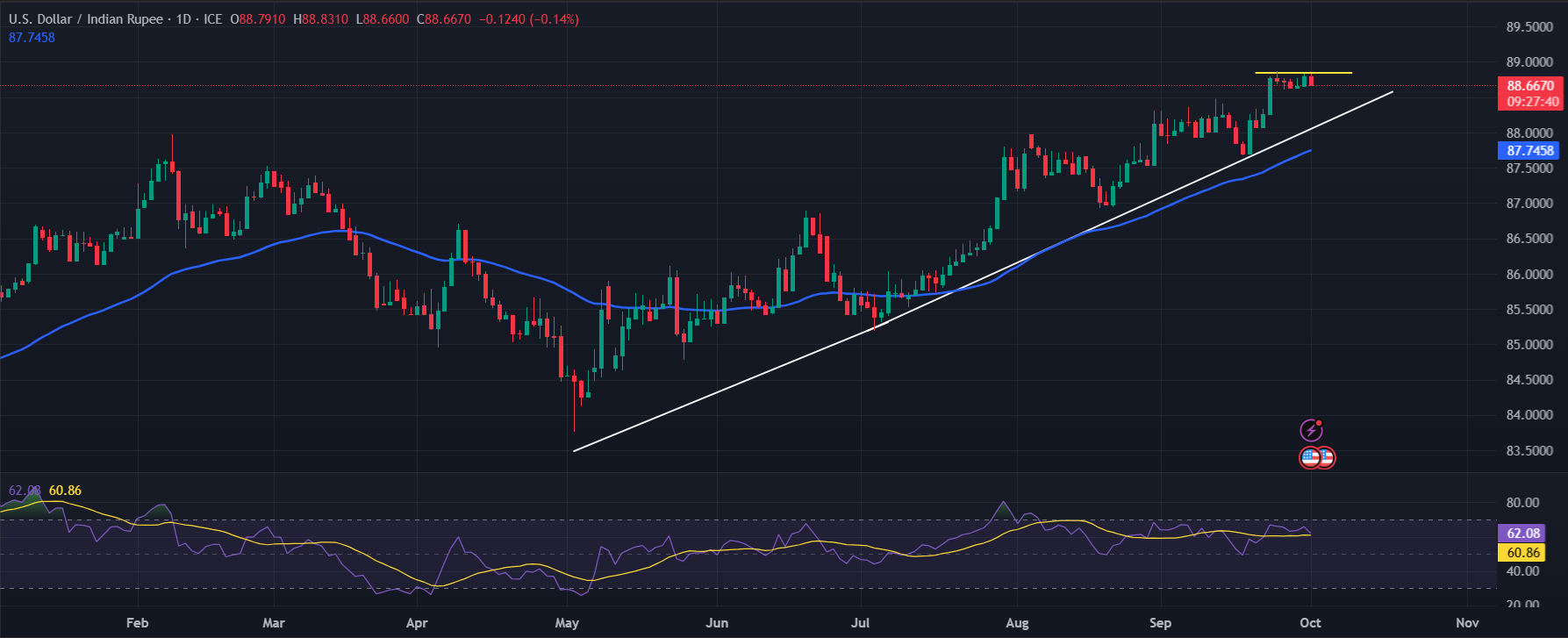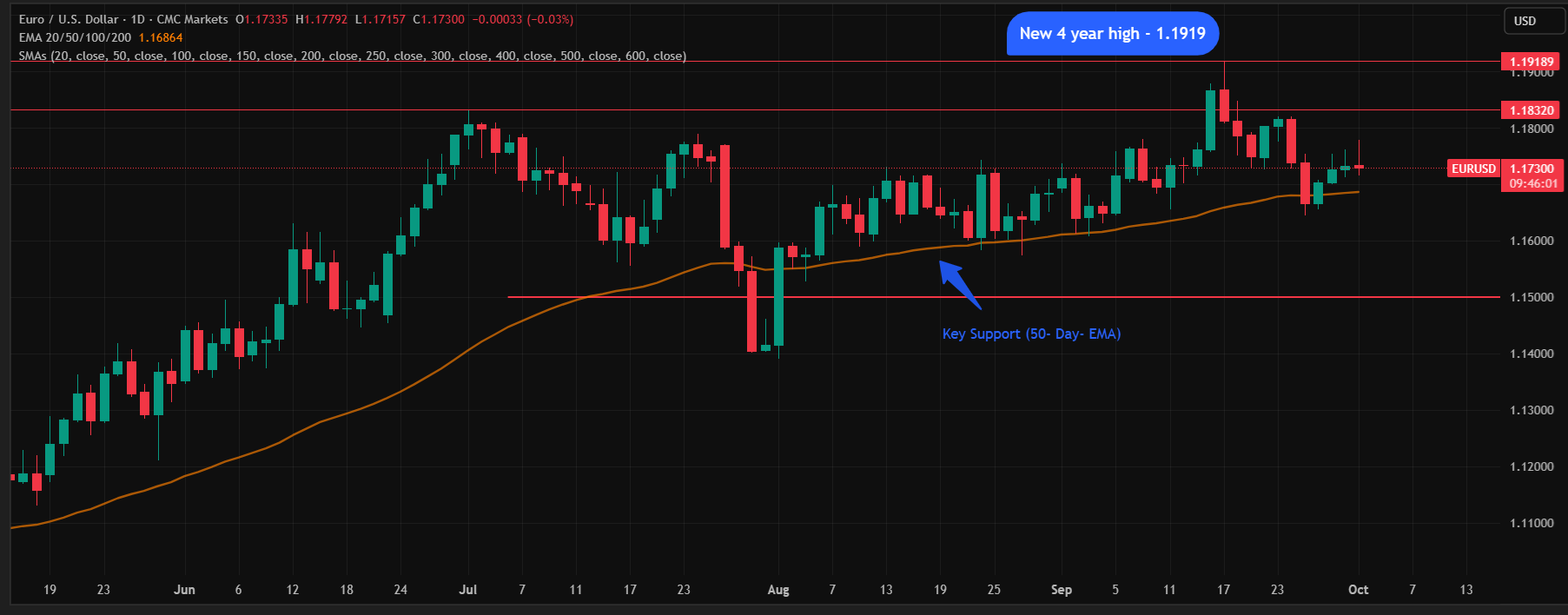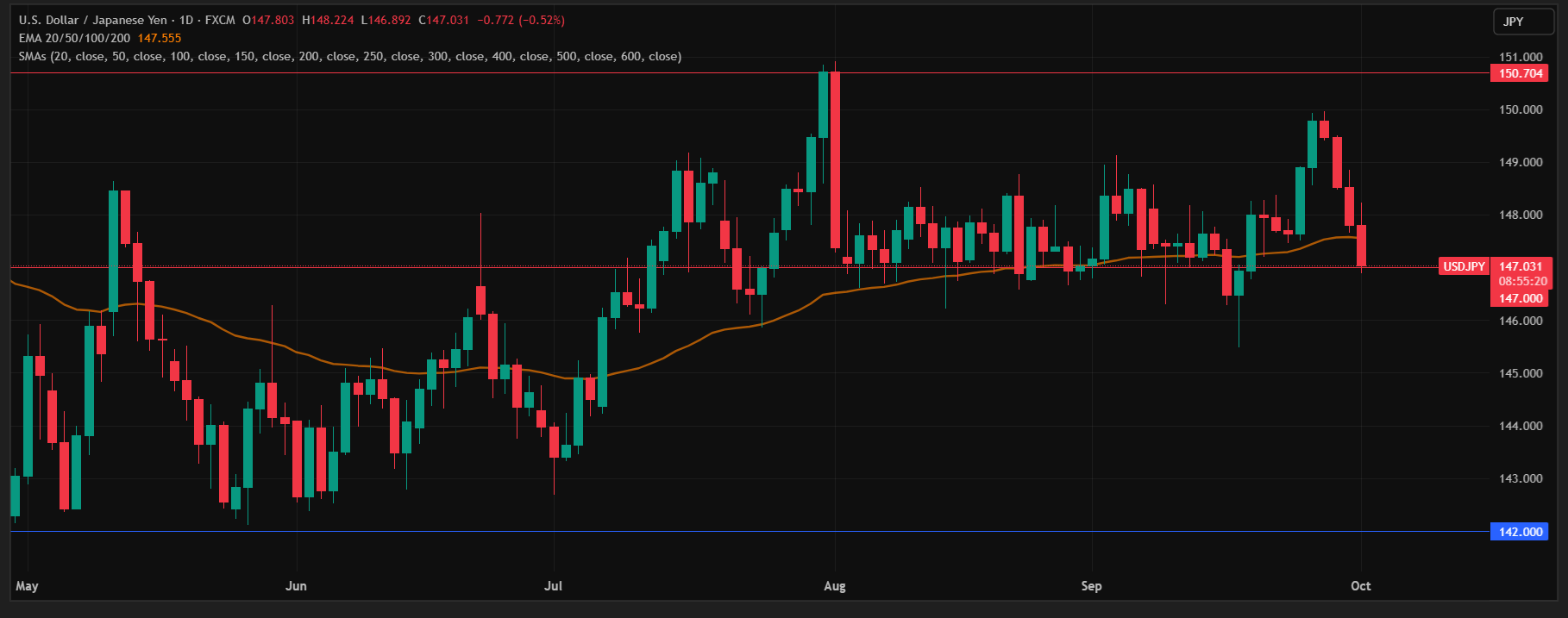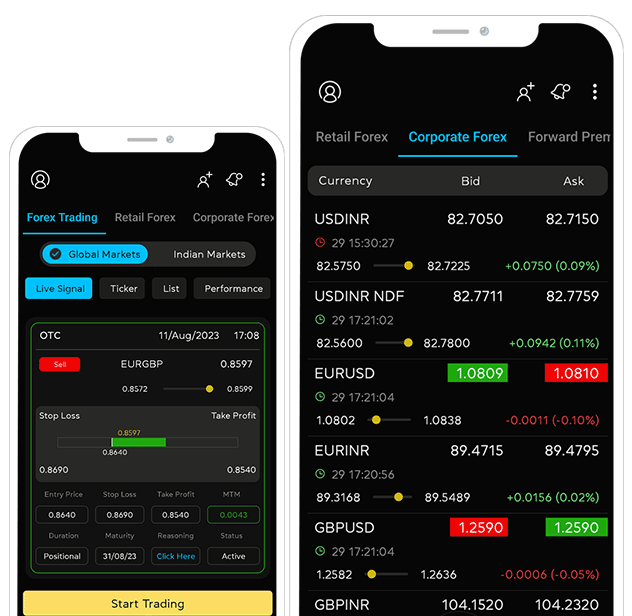Monthly Outlook - October 2025

MONTHLY OUTLOOK
USDINR Fundamental
The USDINR pair extended its decline for the fifth straight month in September and ended the month at 88.79, highlighting persistent weakness in the rupee. During the period, it slipped to a new all-time low of 88.81 against the dollar, underscoring mounting external and domestic challenges. The move was driven by deteriorating trade and current account balances, alongside sustained foreign investor outflows. Inflation remained a key concern, with CPI accelerating to 2.07%, up from previous 1.61%. This rise not only pressured consumption and business costs but also heightened expectations that the RBI may consider a rate cut to cushion growth.
At the same time, the strength of the U.S. dollar, underpinned by solid U.S. economic activity and elevated Treasury yields, further compounded pressure on the rupee. Additional headwinds came from geopolitical and policy factors. The imposition of steep U.S. tariffs on select Indian exports and the hike in H-1B visa fees raised concerns over trade competitiveness and remittance inflows. These developments dampened investor appetite and added volatility to the currency. Looking ahead, the near-term outlook for the rupee remains cautious. Unless there is a meaningful reversal in U.S. rate expectations or supportive domestic data, the rupee is expected to stay under pressure in the short term, with risks skewed toward further depreciation against the greenback.
USDINR Technical
The Indian Rupee continued its depreciation in September, reaching a new all-time high of 88.81 on the final trading day of the month, marking a 0.67% decline for the month. The unexpected depreciation was primarily driven by the recent hike in tariffs and increased H1-B visa fees. While the U.S. dollar index weakened, dropping to a 3.5-year low of 96.21 after the Fed announced two additional rate cuts in 2025, the typical correlation between the dollar index and USDINR remained disrupted.
Looking at the daily chart of USDINR, the pair surged from a previous high of 88.4275 to 88.81, but momentum has since slowed down. Though the immediate trend appears to be stabilizing, further upside potential remains, likely in the coming weeks. The 14-day RSI almost touched the 70-mark, indicating an approaching overbought condition. The upward-sloping trendline (white line), which has been acting as reliable support since May 25, remains intact and is expected to continue providing support in the near term. The initial resistance is at the all-time high of 88.81, and any breakout above this could push the pair towards 89.50. On the downside, the first support comes from the upward-sloping trendline, followed by another support level at 87.74, which aligns with the 50-day Exponential Moving Average (EMA).
As for the hedging strategy, the approach remains the same. Exporters are advised to hedge but not too aggressively, maintaining a hedge ratio around 40–50%. Importers should remain proactive, hedging whenever the pair experiences a dip, as leaving positions unhedged is not advisable in such uncertain times. In such a volatile environment, a combination of options and forwards is recommended to better manage currency risks.

EURUSD Fundamental
The EURUSD pair reflected a blend of macroeconomic and political influences throughout September, moving within a 1.1610 – 1.1918 range and closing the month near 1.1732, marking a modest monthly appreciation for the euro. Early in the month, stable inflation reinforced confidence in the ECB’s policy and Eurozone manufacturing showed modest contraction, while the services sector remained resilient, supporting overall economic stability, signaling improving economic momentum. Meanwhile, the ECB’s steady policy stance helped maintain stable rate expectations. The Fed delivered a 25-bps rate cut, aligning with dovish market expectations. However, robust GDP growth of 3.8% and steady core PCE inflation underscored underlying U.S. strength, partially offsetting the dollar’s downside, while rising jobless claims prompted markets to price in Fed easing. Meanwhile, Eurozone sentiment improved with a stronger ZEW index, supporting euro resilience. Political factors, including fiscal uncertainty in the U.S. from looming government shutdown risks and domestic protests in Europe, added instability. Overall, the pair is expected to remain fundamentally supported by Eurozone stability and expectations of 43 bps in Fed cuts by year-end .
EURUSD Technical
EURUSD traded mostly higher through the month, fluctuating within the 1.1700–1.1800 range and briefly touching a new four-year high of 1.1919. The rally was initially driven by expectations surrounding the Federal Reserve’s rate decision, as rate cuts provided upward momentum. However, the gains eased after Fed Chair Powell’s cautious remarks tempered market optimism, pulling the pair back toward the 1.1700 region, which now serves as immediate support. Technically, 1.1800 remains a strong psychological resistance, positioned just below the multi-year high of 1.1832. Although the pair tested levels above 1.1900 during the month, the inability to sustain a close above prior high highlights the persistent selling pressure in that zone. On the downside, the 50-day EMA around 1.1700 offers near-term support, while a break below could extend losses toward 1.1500. Overall, a dip-buying bias remains intact, with a decisive close above 1.1800 required to confirm renewed bullish momentum.

GBPUSD Fundamental
The GBPUSD pair weakened in September, pressured by the broader strength of the U.S. dollar and cautious sentiment around the UK economy. Though it touched a 2 month high of 1.3726 as the fed cut interest rate by 25 bps. Inflation remained unchanged at 3.8% indicating a softening of price pressures, helping to reduce some urgency around further monetary tightening by the BoE. Meanwhile, recent GDP figures showed that the UK economy grew by 1.4% year-on-year in Q2 2025, outperforming expectations and lending a measure of confidence to the recovery. That said, the pair remained vulnerable to external factors—U.S. dollar strength, global risk sentiment, and shifting rate expectations abroad all weighed on upside momentum. While Q2 GDP growth of 1.4% offers support to GBP, dissent from two BoE policymakers calling for rate cuts limits upside. The pound’s outlook remains fragile, as continued U.S. dollar strength could trigger weakness unless tempered by weaker U.S. data or dovish Fed commentary.
GBPUSD Technical
The GBPUSD pair declined 0.33% in September, failing to sustain last month’s positive momentum, and closed at 1.1732, below the prior month’s close—signaling weakness. Price action remained volatile within a 403-pip range, with the pair initially advancing to a 3-month high of 1.3726 before retracing lower. Despite the pullback, the broader upward channel structure remains intact. The MACD indicator is showing early signs of a potential bullish crossover, with the MACD line marching upwards toward the signal line near the zero axis. On the upside, immediate resistance lies at 1.3726, and a breakout above this would open the path toward the upper boundary of the ascending channel. On the downside, the channel support remains a key level to watch. Exporters are advised to consider hedging opportunities above 1.3600, while importers should monitor for dips toward channel support to optimize hedging decisions.
.png)
USDJPY Fundamental
The USDJPY pair experienced significant volatility, opening near 147.41, peaking at 149.957, and closing at 147.803, driven by divergent U.S. and Japanese economic signals. Early in the month, the Dollar briefly weakened following the Fed's decision, but this was quickly offset by Chair Powell's hawkish comments, which emphasized caution and limited the market's expectation for further rate cuts. This bolstered the Dollar and pushed USDJPY higher. Simultaneously, the Bank of Japan's meeting provided no concrete indication of an imminent rate hike, reinforcing the wide US-Japan interest rate gap and keeping the Yen weak. Looking ahead, USDJPY is likely to face downward pressure due to policy divergence. Japan’s Manufacturers Index data showed stronger business sentiment, raising BOJ rate hike odds for October. A U.S. government shutdown and weak data could spur further Fed easing, targeting 3.75%-4.00%. U.S. inflation, retail sales, and BOJ future comments will be pivotal. Risks include U.S. fiscal gridlock and trade tensions boosting yen safe-haven demand.
USDJPY Technical
USDJPY opened the month at 147 and slipped to a monthly low of 145.48 by mid-month, following the Federal Reserve’s 25 bps rate cut — its first in nine months. For most of the month, the pair traded within a tight 147–148 range, before rallying sharply toward the 150 mark late in the month, driven by stronger-than-expected U.S. GDP data and the Bank of Japan’s cautious comments, which signaled no imminent rate hike. Throughout the period, USDJPY consistently found support near the 147.00 zone, aligning with the 50-day EMA and acting as a crucial pivot. A brief dip below this level briefly raised the risk of deeper declines toward 146.00 (S1) and 145.00 (S2), both historically strong supports. On the upside, while the pair reclaimed the 147–148 range, sustained gains toward 150–151 appear uncertain amid rising BoJ hike expectations. Overall, the broader uptrend remains intact, with consolidation likely to build a base for renewed upside momentum.

Recent Blog
Want to manage Forex?
Newsletter signup
Receive forex updates right in your mail box or Whatsapp













